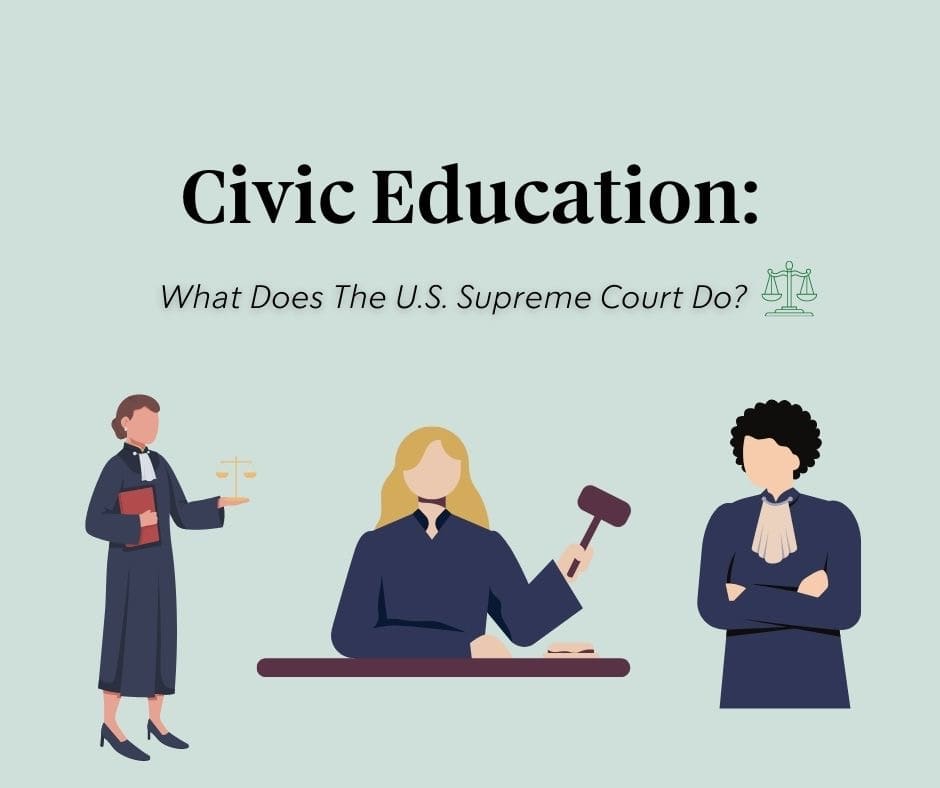
What Does The Supreme Court Do?
Join us and spread the word to your community
What is the Supreme Court?
- The Supreme Court is the highest court in the United States and was established in Article III of the Constitution and the first Supreme Court was created by Congress in 1789.
- The overall job of the Supreme Court is to ensure that federal law — the Constitution and laws passed by Congress — are the same across the country. The most well-known power of the Supreme Court is judicial review, where justices interpret the Constitution and decide whether a statute is constitutional or not. The Supreme Court has ultimate appelate jurisdiction, meaning it has the power to reverse or modify a lower court’s decision.
- The Supreme Court term begins on the first Monday in October and remains in session until late June or early July.
Who is on the Supreme Court?
- There are nine Justices on the Supreme Court, with the most senior member serving as the Chief Justice. The rest are known as Associate Justices.
- When a vacancy arises, Justices are nominated by the U.S. president and confirmed by the U.S. Senate with a simple majority vote. Justices have no term limits, so they may serve continuously unless they are impeached and removed from office, if they decide to retire, or even until death.
- The current Justices, in order of seniority, are John G. Roberts, Jr., Clarence Thomas, Stephen G. Breyer, Samuel A. Alito, Jr., Sonia Sotomayor, Elena Kagan, Neil M. Gorsuch, Brett M. Kavanaugh, and Amy Coney Barrett. Before the next term, Justice Breyer will retire and be replaced by Justice Ketanji Brown Jackson.
- Congress has the power to determine how many Justices serve on the Supreme Court, and there have been anywhere from six to ten throughout U.S. history.
How does a case get to the Supreme Court?
- Cases usually start at the lowest level in the federal court system, in a district court, before being appealed up until finally reaching the Supreme Court. But moving up through the courts doesn’t guarantee a case will eventually be heard by the Supreme Court.
- More than 7,000 cases petition to be heard each term, but only about 80 cases are chosen.
- A case is generally chosen if it is of national importance, if a lower court issued a ruling in the case that invalidated federal law, or to solve a split decision in lower courts. At least four of the nine Justices must vote to accept a case for it to be heard.
Why do Supreme Court cases and decisions matter?
- The Supreme Court’s rulings are the final say on a case, as there is no higher court above the Supreme Court to appeal to. Once the Supreme Court has issued a final ruling, lower courts must apply their interpretation to similar cases.
- The Supreme Court can decide if a law or action is unconstitutional, acting as a check on the other branches of government. Legislation has been stuck down by SCOTUS rulings many times, and justices have even overturned prior Supreme Court decisions.
How to stay informed on the Supreme Court
- Learn more details about the Supreme Court on their official government website. You can read official opinions, search the court’s calendar and schedule, or learn more about it’s history. They also offer a free email subscription to receive updates on U.S. courts.
- SCOTUSblog is an independent news and analysis website dedicated to covering the Supreme Court year round.